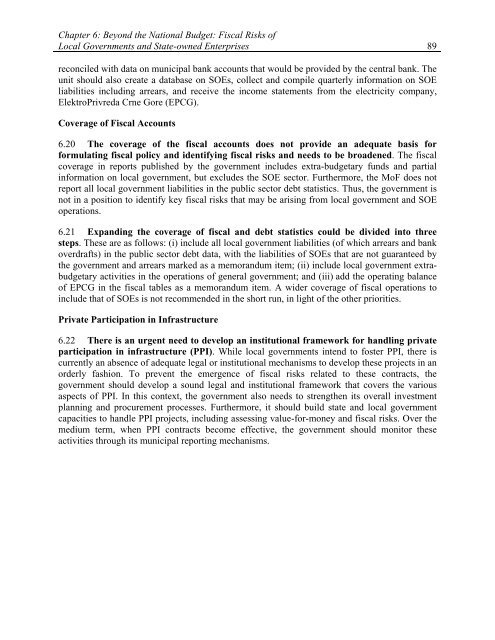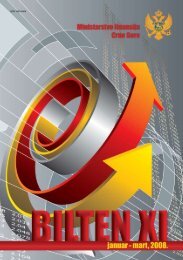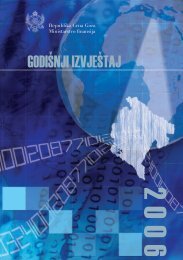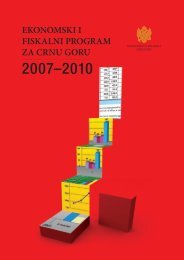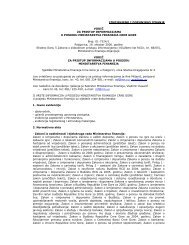Republic of Montenegro: Public Expenditure and ... - Vlada Crne Gore
Republic of Montenegro: Public Expenditure and ... - Vlada Crne Gore
Republic of Montenegro: Public Expenditure and ... - Vlada Crne Gore
Create successful ePaper yourself
Turn your PDF publications into a flip-book with our unique Google optimized e-Paper software.
Chapter 6: Beyond the National Budget: Fiscal Risks <strong>of</strong><br />
Local Governments <strong>and</strong> State-owned Enterprises 89<br />
reconciled with data on municipal bank accounts that would be provided by the central bank. The<br />
unit should also create a database on SOEs, collect <strong>and</strong> compile quarterly information on SOE<br />
liabilities including arrears, <strong>and</strong> receive the income statements from the electricity company,<br />
ElektroPrivreda <strong>Crne</strong> <strong>Gore</strong> (EPCG).<br />
Coverage <strong>of</strong> Fiscal Accounts<br />
6.20 The coverage <strong>of</strong> the fiscal accounts does not provide an adequate basis for<br />
formulating fiscal policy <strong>and</strong> identifying fiscal risks <strong>and</strong> needs to be broadened. The fiscal<br />
coverage in reports published by the government includes extra-budgetary funds <strong>and</strong> partial<br />
information on local government, but excludes the SOE sector. Furthermore, the MoF does not<br />
report all local government liabilities in the public sector debt statistics. Thus, the government is<br />
not in a position to identify key fiscal risks that may be arising from local government <strong>and</strong> SOE<br />
operations.<br />
6.21 Exp<strong>and</strong>ing the coverage <strong>of</strong> fiscal <strong>and</strong> debt statistics could be divided into three<br />
steps. These are as follows: (i) include all local government liabilities (<strong>of</strong> which arrears <strong>and</strong> bank<br />
overdrafts) in the public sector debt data, with the liabilities <strong>of</strong> SOEs that are not guaranteed by<br />
the government <strong>and</strong> arrears marked as a memor<strong>and</strong>um item; (ii) include local government extrabudgetary<br />
activities in the operations <strong>of</strong> general government; <strong>and</strong> (iii) add the operating balance<br />
<strong>of</strong> EPCG in the fiscal tables as a memor<strong>and</strong>um item. A wider coverage <strong>of</strong> fiscal operations to<br />
include that <strong>of</strong> SOEs is not recommended in the short run, in light <strong>of</strong> the other priorities.<br />
Private Participation in Infrastructure<br />
6.22 There is an urgent need to develop an institutional framework for h<strong>and</strong>ling private<br />
participation in infrastructure (PPI). While local governments intend to foster PPI, there is<br />
currently an absence <strong>of</strong> adequate legal or institutional mechanisms to develop these projects in an<br />
orderly fashion. To prevent the emergence <strong>of</strong> fiscal risks related to these contracts, the<br />
government should develop a sound legal <strong>and</strong> institutional framework that covers the various<br />
aspects <strong>of</strong> PPI. In this context, the government also needs to strengthen its overall investment<br />
planning <strong>and</strong> procurement processes. Furthermore, it should build state <strong>and</strong> local government<br />
capacities to h<strong>and</strong>le PPI projects, including assessing value-for-money <strong>and</strong> fiscal risks. Over the<br />
medium term, when PPI contracts become effective, the government should monitor these<br />
activities through its municipal reporting mechanisms.


